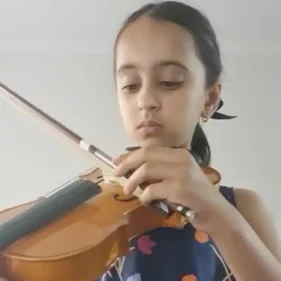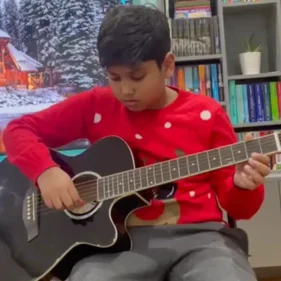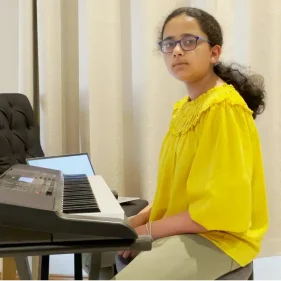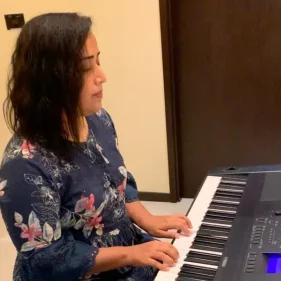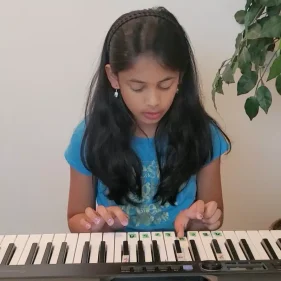Have you ever heard the beautiful Carnatic song, “Alai Payuthe Kanna”? If not, you’re in for a real treat! Composed by Oothukadu Venkata Subbaiyer, is one of the most beloved Carnatic compositions of all time. Let’s take a closer look at its history and meaning. Along with alaipayuthey kanna lyrics in english as well as tamil.
Theme of the Alaipayuthey Kanna Song
Alaipayuthey Kanna lyrics meaning portrays that the woman stands in the meadow, looking for her beloved flautist, longing and filled with sadness. The soothing melody of the flute helps to calm her restless heart. She desires to reunite her in a tranquil forest where he will make her feel alive again. Her feelings range from intense love to doubt and jealousy as she questions the fairness of life. Alaipayuthey Kanna lyrics meaning perfectly conveys these emotions. Her heart rises and falls in a cycle of love, sorrow and hope as she awaits his return.
Alaipayuthey kanna composer Oothukadu Venkata Subbaiyer (c. 1700-1765) conveys a longing for spirituality in his Kriti ‘Alai Payude Kanna’. Here he depicted Radha’s waiting for Krishna is symbolic of bhaktas’ desire for union with the divine. We beg for Moksha, just as she begs for union. It is like a release from this cycle of birth and death so that we may be united with the divine.
The melody played by flautist takes one into a meditative state. This evokes feelings of grief and doubt due to jealousy and lack of faith. The restless mind constantly seeks the Lord like an ocean’s never-ending waves. Though the material world distracts her from her spiritual goal, she never stops believing in true love. The song ends on a beautiful note of hope for union with Him. From Radha’s struggle and longing to our own, ‘Alai Payuthe Kanna song’ reminds us that we will be reunited one day with what we seek.

Did You Know?
Alaipayuthey kanna ragam Kanada is one of the most melodious Carnatic ragam in Shringara rasa and is a Vakra Sampurna raag with Swars sung in Zig-Zag pattern.
The alaipayuthey kanna composer Oothukadu Venkata Subbaiyer expresses sadness in Raga Kanada by using a melody that follows the movement of waves, with rising and falling notes. The following are the alaipayuthey kanna lyrics in english, tamil.
Alaipayuthe Kanna Notes
Alaipayuthey Kanna Song Lyrics In English
Alaipayuthey Kannaa
En Manam Alaipayuthey
Aanandha Mogana Venu Gaanamadhil
Alaipayuthey Kannaa
En Manam Alaipayuthey
Un Aanandha Mogana Venu Gaanamadhil
Alaipayuthey Kannaa Aaaa…
(Nilaipeyaraadhu
Silaipolavae Nindru)…….. (2 times)
Neramaavadhariyaamalae
Miga Vinodhamaana
Muraleedharaa En Manam
Alaipayuthey Kannaa Aaaa…
(Thelindha Nilavu
Pattappagal Pol Eriyudhae)…….(2 times)
Dhikkai Nokkien Puruvam Neriyudhae
{Kanindha Un Venugaanam
Kaatril Varugudhae}…….(2 times)
{Kangal Sorugi Oru Vidhamaai
Varugudhae}…….(2 times)
(Kadhiththa Manaththil
Oruththi Padhaththai
Enakku Aliththu Magizhththavaa)…….(2 times)
(Oru Thaniththa Manaththil
Anaiththu Enakku
Unarchchi Koduththu Mugizhththavaa)…….(2 times)
(Kanai Kadal Alaiyinil
Kadhiravan Oliyena
Inaiyiru Kazhalena Kaliththavaa)…….(2 times)
(Kadhari Manamurugi Naan Azhaikkavo
Idhara Maadharudan
Nee Kalikkavo)…….(2 times)
(Idhu Thagumo
Idhu Muraiyo
Idhu Dharmam Thaano)…….(2 times)
Kuzhaloodhidum Pozhudhu
Aadigum Kuzhaigal Polavae
Manadhu Vedhanai Migavodu
Alaipayuthey Kannaa
En Manam Alaipaayudhae
Un Aanandha Mogana Venu Gaanamadhil
Alaipayuthey Kannaa Aaaa…Aaa…
Meaning Behind Alaipayuthey Kanna Song
Alaipayuthey meaning ‘the waves are flowing’ herein speaks about the emotional waves that rise within the protagonist’ heart fighting against a turmoil that comes with deep affection. With that being said, Alaipayuthey Kanna lyrics in tamil capture the essence of falling in love so beautifully.
Alaipayuthey Kanna Song Lyrics In Tamil
அலைபாயுதே கண்ணா,
என் மனம் மிக அலைபாயுதே
உன் ஆனந்த மோகன வேணுகானம் அதில்
அலைபாயுதே கண்ணா,
என் மனம் மிக அலைபாயுதே
உன் ஆனந்த மோகன வேணுகானம் அதில்
நிலை பெயராது சிலை போலவே நின்று
நேரமாவதறியாமலே மிக விநோதமாக முரளீதரா
என் மனம் (அலைபாயுதே)
தெளிந்த நிலவு பட்டப்பகல் போல் எரியுத
தெளிந்த நிலவு பட்டப்பகல் போல் எரியுதே
திக்கை நோக்கி என் இரு புருவம் நெரியுதே
கனிந்த உன் வேணுகானம் காற்றில் வருகுதே
கனிந்த உன் வேணுகானம் காற்றில் வருகுதே
கண்கள் சொருகி ஒரு விதமாய் வருகுதே
கண்கள் சொருகி ஒரு விதமாய் வருகுதே
கதித்த மனத்தில் உருத்தி பதத்தை
எனக்கு அளித்து மகிழ்த்தவா
கதித்த மனத்தில் உருத்தி பதத்தை
எனக்கு அளித்து மகிழ்த்தவா
ஒரு தனித்த வனத்தில் அணைத்து எனக்கு
உணர்ச்சி கொடுத்து முகிழ்த்தவா
ஒரு தனித்த வனத்தில் அணைத்து எனக்கு
உணர்ச்சி கொடுத்து முகிழ்த்தவா
கனை கடல் அலையினில் கதிரவன் ஒளியென
இணையிரு கழலெனக்-அளித்தவா
கனை கடல் அலையினில் கதிரவன் ஒளியென
இணையிரு கழலெனக்-அளித்தவா
கதறி மனமுருகி நான் அழைக்கவோ
இதர மாதருடன் நீ களிக்கவோ
கதறி மனமுருகி நான் அழைக்கவோ
இதர மாதருடன் நீ களிக்கவோ
இது தகுமோ, இது முறையோ, இது தருமம் தானோ?
இது தகுமோ, இது முறையோ, இது தருமம் தானோ?
குழலூதிடும் பொழுது ஆடிடும் குழைகள்
போலவே மனது வேதனை மிகவொடு
அலைபாயுதே கண்ணா, என் மனம் மிக அலைபாயுதே
உன் ஆனந்த மோகன வேணுகானம் அதில்
அலைபாயுதே கண்ணா

Did You Know?
Alaipayuthey Kanna lyrics malayalam was translated by Kaithapram Damodaran Namboothri.
There are also alaipayuthey kanna lyrics in kannada that you may want to check. Now look at this awesome recital by famous carnatic musician Sudha Raghunathan.
FAQs
What is the meaning of Alaipayuthey Kanna lyrics?
Allaipayuthey kanna lyrics tamil expresses the longing and devotion to Lord Krishna and conveys yearning and connection in a poetic way.
Who composed the Alaipayuthey Kanna song?
Shri.Oothukadu Venkata Subbaiyer composed the Alaipayuthey Kanna song.
What is the significance of Alaipayuthey Kanna in Tamil culture?
Alaipayuthey Kanna blends devotion to Krishna with affection and longing, reflecting Tamil spiritual, emotional, and cinematic cultural heritage beautifully.
Which movie features Alaipayuthey Kanna?
'Alaipayuthey Kanna’ features in the movie called ‘Alaipayuthe’ directed by Mani Ratnam.
What makes Alaipayuthey Kanna special musically?
The keerthanai ‘Alaipayuthey Kanna’ is based on an intricate yet romantic raga and is popular for its melodic patterns of swaras.
What is the story behind the Alaipayuthey Kanna song?
In simple words, a woman in a meadow finds solace in the melody played by a flautist while battling love, doubt and hope.
What is the raga and tala of Alaipayuthey Kanna?
Alaipayuthey kanna ragam is Kanada, and based on Adi tala.
Are there any tutorials or lessons available for Alaipayuthey Kanna?
There are dozens of tutorial videos and blogs on internet available for learning Alaipayuthey Kanna.
Related blog: Krishna Nee Begane Baro





















